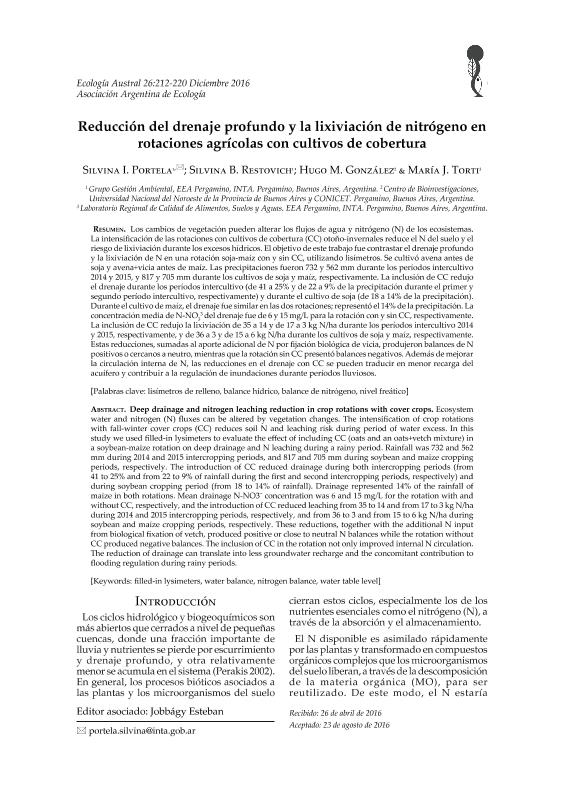Artículo
Los cambios de vegetación pueden alterar los flujos de agua y nitrógeno (N) de los ecosistemas. La intensificación de las rotaciones con cultivos de cobertura (CC) otoño-invernales reduce el N del suelo y el riesgo de lixiviación durante los excesos hídricos. El objetivo de este trabajo fue contrastar el drenaje profundo y la lixiviación de N en una rotación soja-maíz con y sin CC, utilizando lisímetros. Se cultivó avena antes de soja y avena+vicia antes de maíz. Las precipitaciones fueron 732 y 562 mm durante los períodos intercultivo 2014 y 2015, y 817 y 705 mm durante los cultivos de soja y maíz, respectivamente. La inclusión de CC redujo el drenaje durante los períodos intercultivo (de 41 a 25% y de 22 a 9% de la precipitación durante el primer y segundo período intercultivo, respectivamente) y durante el cultivo de soja (de 18 a 14% de la precipitación). Durante el cultivo de maíz, el drenaje fue similar en las dos rotaciones; representó el 14% de la precipitación. La concentración media de N-NO3 3 del drenaje fue de 6 y 15 mg/L para la rotación con y sin CC, respectivamente. La inclusión de CC redujo la lixiviación de 35 a 14 y de 17 a 3 kg N/ha durante los períodos intercultivo 2014 y 2015, respectivamente, y de 36 a 3 y de 15 a 6 kg N/ha durante los cultivos de soja y maíz, respectivamente. Estas reducciones, sumadas al aporte adicional de N por fijación biológica de vicia, produjeron balances de N positivos o cercanos a neutro, mientras que la rotación sin CC presentó balances negativos. Además de mejorar la circulación interna de N, las reducciones en el drenaje con CC se pueden traducir en menor recarga del acuífero y contribuir a la regulación de inundaciones durante períodos lluviosos. Ecosystem water and nitrogen (N) fluxes can be altered by vegetation changes. The intensification of crop rotations with fall-winter cover crops (CC) reduces soil N and leaching risk during period of water excess. In this study we used filled-in lysimeters to evaluate the effect of including CC (oats and an oats+vetch mixture) in a soybean-maize rotation on deep drainage and N leaching during a rainy period. Rainfall was 732 and 562 mm during 2014 and 2015 intercropping periods, and 817 and 705 mm during soybean and maize cropping periods, respectively. The introduction of CC reduced drainage during both intercropping periods (from 41 to 25% and from 22 to 9% of rainfall during the first and second intercropping periods, respectively) and during soybean cropping period (from 18 to 14% of rainfall). Drainage represented 14% of the rainfall of maize in both rotations. Mean drainage N-NO3¯ concentration was 6 and 15 mg/L for the rotation with and without CC, respectively, and the introduction of CC reduced leaching from 35 to 14 and from 17 to 3 kg N/ha during 2014 and 2015 intercropping periods, respectively, and from 36 to 3 and from 15 to 6 kg N/ha during soybean and maize cropping periods, respectively. These reductions, together with the additional N input from biological fixation of vetch, produced positive or close to neutral N balances while the rotation without CC produced negative balances. The inclusion of CC in the rotation not only improved internal N circulation. The reduction of drainage can translate into less groundwater recharge and the concomitant contribution to flooding regulation during rainy periods.
Reducción del drenaje profundo y la lixiviación de nitrógeno en rotaciones agrícolas con cultivos de cobertura
Título:
Deep drainage and nitrogen leaching reduction in crop rotations with cover crops
Fecha de publicación:
10/2016
Editorial:
Asociación Argentina de Ecología
Revista:
Ecología Austral
ISSN:
1667-7838
Idioma:
Español
Tipo de recurso:
Artículo publicado
Clasificación temática:
Resumen
Palabras clave:
LISÍMETROS DE RELLENO
,
BALANCE DE NITRÓGENO
,
BALANCE HÍDRICO
,
NIVEL FREÁTICO
Archivos asociados
Licencia
Identificadores
Colecciones
Articulos(SEDE CENTRAL)
Articulos de SEDE CENTRAL
Articulos de SEDE CENTRAL
Citación
Portela, Silvina Isabel; Restovich, Silvina Beatriz; Gonzalez, Hugo Martín; Torti, Maria Juliana; Reducción del drenaje profundo y la lixiviación de nitrógeno en rotaciones agrícolas con cultivos de cobertura; Asociación Argentina de Ecología; Ecología Austral; 26; 3; 10-2016; 212-220
Compartir
Altmétricas




